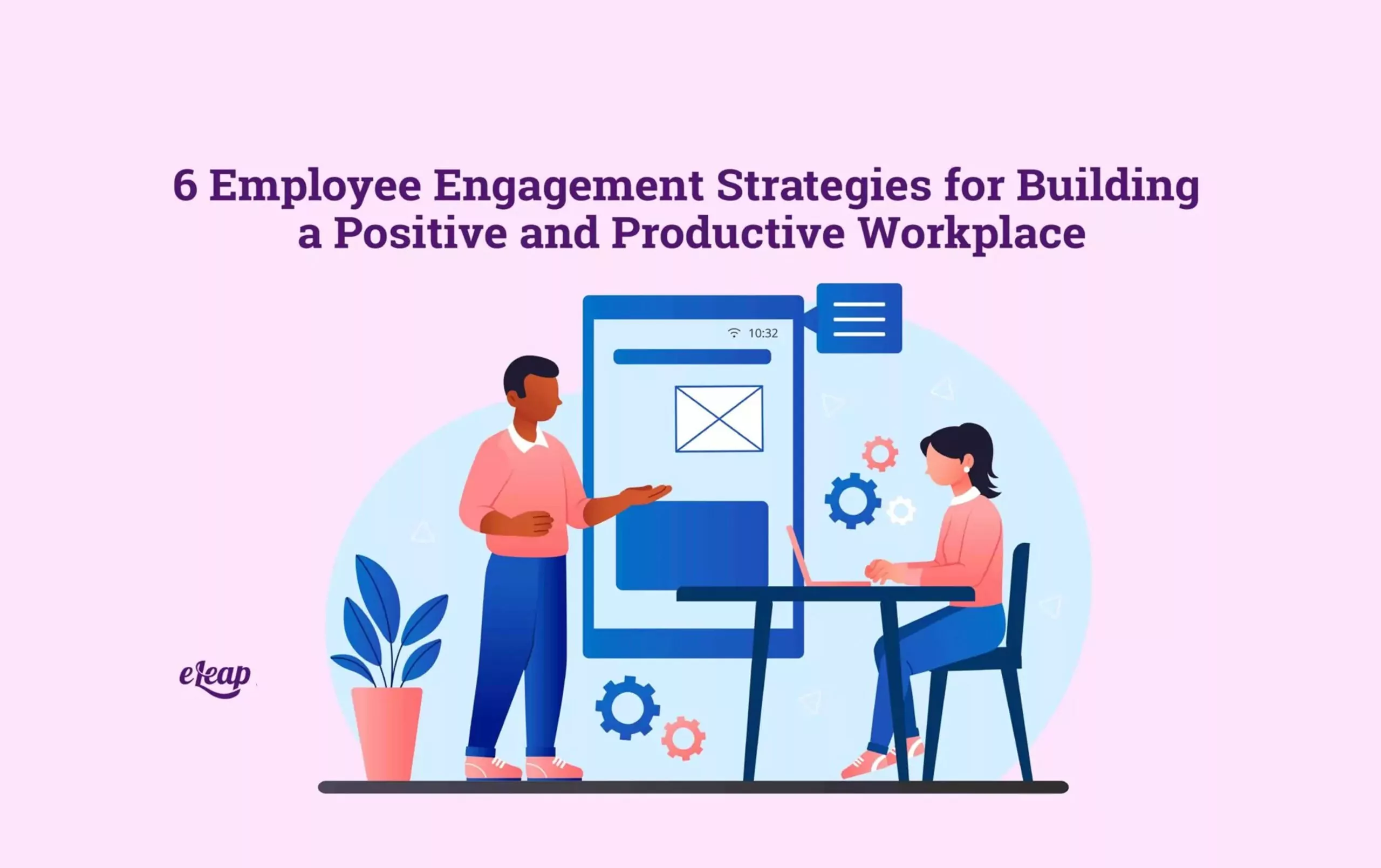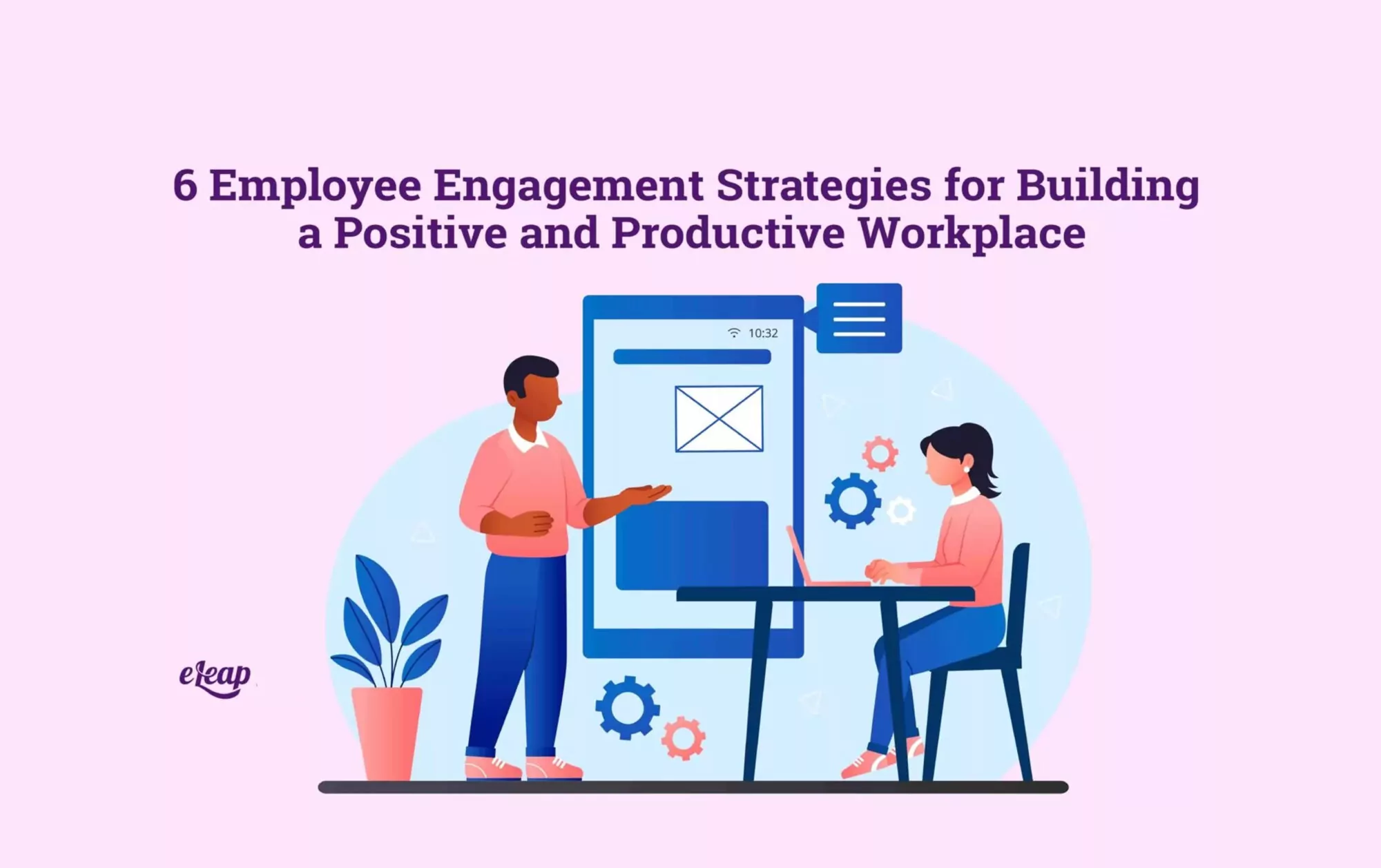6 Employee Engagement Strategies for Building a Positive and Productive Workplace

What makes a work environment a functional place of work? Is it the industrial tools and equipment, the available facilities, or the office premises? No, it’s the human capital, otherwise called the employees, that determines the output and future of your organization. Therefore, you need effective employee engagement strategies to make your organization thrive. Explore how eLeaP®’s Performance Management Platform can simplify evaluations, boost productivity, and drive measurable results.
The more engaged your employees are, the better it is for your organization. When you utilize various employee engagement ideas, you are giving your employees more wings to fly and opening up your organization for the unique benefits of an increased employee engagement rate.

Below are best practices to foster employee engagement and build a positive and productive workplace.
1. Promote Open Communication
One way to boost employee engagement is to grant them the liberty to give and receive information. Naturally, effective communication should be a two-way thing. Therefore, as a manager, you will be doing yourself a lot of disservice by only dispensing out information to employees but not allowing them to do the same. An organization that practices this will most likely suffer from non-existent employee engagement.
A transparent and open communication system boosts employee engagement, allowing a positive and productive work environment. Employees who are given a chance to air their views, provide feedback, and share their opinions often experience job satisfaction to a greater extent.
2. Recognize And Praise Good Work
Human love praises, which is an excellent tool to inspire your employees. A manager who overlooks outstanding performances is edging his organization towards a reduced employee engagement rate. Employees who feel you don’t recognize their efforts become demotivated to perform more quality work.
However, when management recognizes and publicly praises its employees’ excellent work, every team member will strive to perform excellently so they can be identified. Also, adopting a reward system is one of the best employee engagement strategies that will go a long way in achieving the overarching aim of the organization – productivity.
3. Focusing On Employee’s Well-being
Managers who pay attention to the well-being of their employees are directly investing in such employees’ emotional needs. The benefits of focusing on employee welfare are countless, as it’s a significant factor in boosting employee engagement within the organization. It makes the employee emotionally connected to the workplace, resulting in high productivity. Here are examples of employee well-being elements that you can implement:
- Provision of health insurance and medical cover.
- Integration of bonuses and allowances.
- Providing sanitary needs like hygienic restrooms.
- Sufficient breaks in between work shifts.
- Encouraging work-life balance through vacation provisions.
- Providing job security.
4. Sketch A Success Roadmap
It’s not enough that employees come to work, passively participate in activities, and get paid. Employees should know there are good growth prospects for the particular role they are filling. Therefore, sketching an appropriate success roadmap is a solid pillar for a successful employee engagement strategy. Scheduling career counseling sessions or penning out a precise career advancement would do you a lot of good in boosting employee engagement in this instance.
5. Offer Avenue For Personal Growth
This is a fundamental part of human capital management. As a people manager, you should cultivate and polish every human asset to accomplish your long-term growth. For instance, if you run a training program or provide allowances and sabbatical leaves for employees desiring to pursue higher education, you are investing in your organization’s future and developing a degree of loyalty amongst your employees.
This is one of the most notable employee engagement strategies used by top organizations. Offering an avenue for personal growth is a win-win for your organization because as your employees grow, they become more creative, and their skills are sharpened to deliver effectively. They become confident in sharing their knowledge and ideas with others within your organization. In other words, restricting your employees from thriving professionally will do more harm than good to your organization.
Characteristics of a Positive And Productive Work Environment
There are several qualities of a positive and productive work environment. Here are some of its notable features:
Positive Thinking
Employees who work in a positive work environment tend to be positive thinkers. This is because they can swiftly communicate their challenges. Productivity in such an organization is non-negotiable, as every hindrance is handled appropriately.
Strong Work Ethics
Work ethics such as discipline and respect promote good relationships, collaboration, and cooperation. This aids the establishment of a positive and productive work environment.
Empathetic Team Members
An organization that permits employee collaboration and bonding breeds empathetic team members. Every individual looks out for other team members and serves as a support system for their contemporaries. This strengthens their relationships and improves their engagement rate.
Benefits Of A Positive Work Environment
There are numerous benefits to maintaining a positive work environment. Some of them are:
- It boosts the employees’ sense of belonging.
- It encourages team collaboration and cooperation.
- A positive work environment promotes employees’ career growth.
- It increases employees’ loyalty.
- It reduces employee turnover.
Final Thoughts
Never underrate the power of a positive work environment because it benefits the organization as much as it helps the employee. Satisfied employees expend all they can to meet and exceed the management’s expectations. The derived satisfaction is the motivating factor that drives employees to become more effective in the organization.
Setting customized goals is an efficient way to increase employee engagement and performance. Hence, you need a reliable platform to simplify the goal-setting process and ensure that your employees are on the same page. Interestingly, you don’t have to be stressed to find such a platform; eLeaP is notable for this. It is a goal-setting platform that makes it easier to set employee goals, increasing employee engagement.